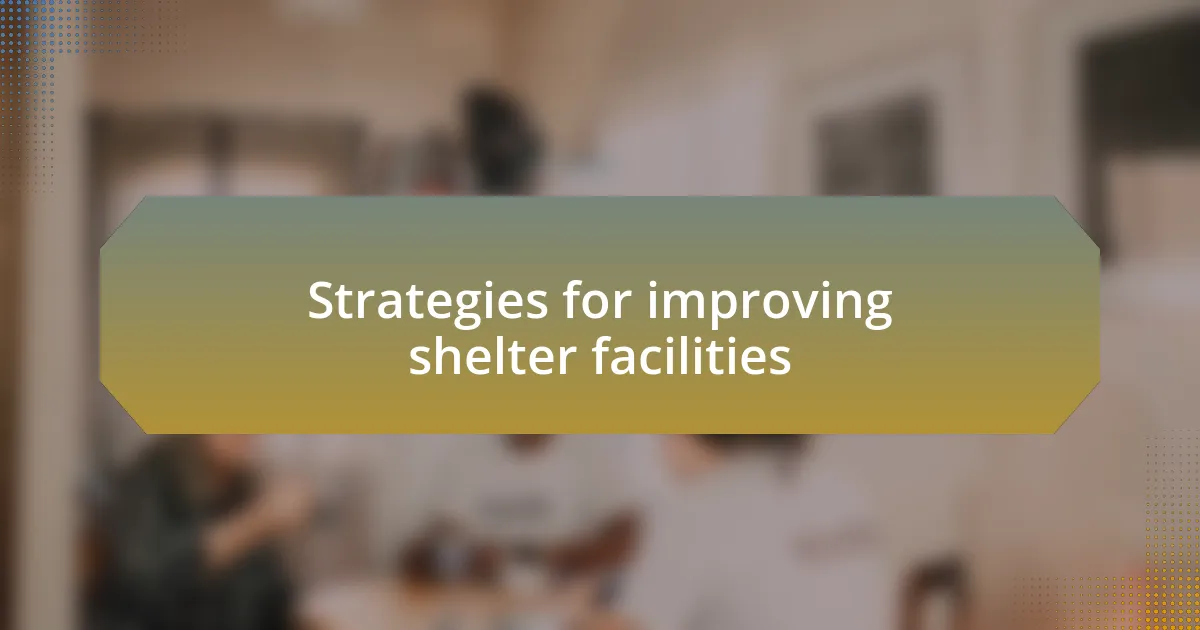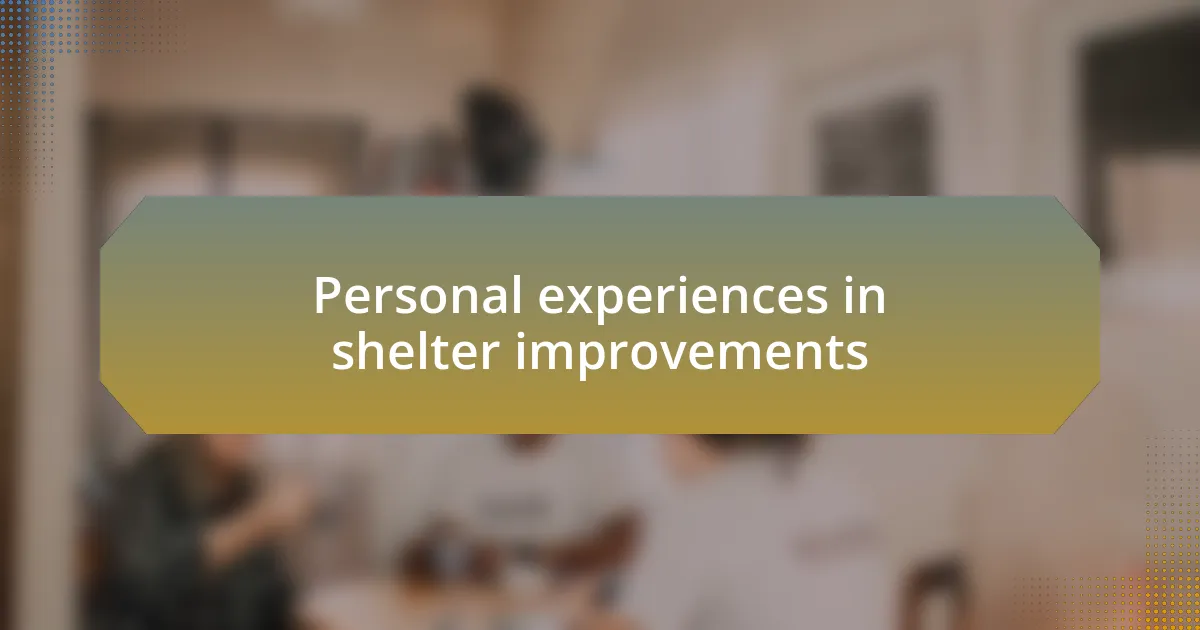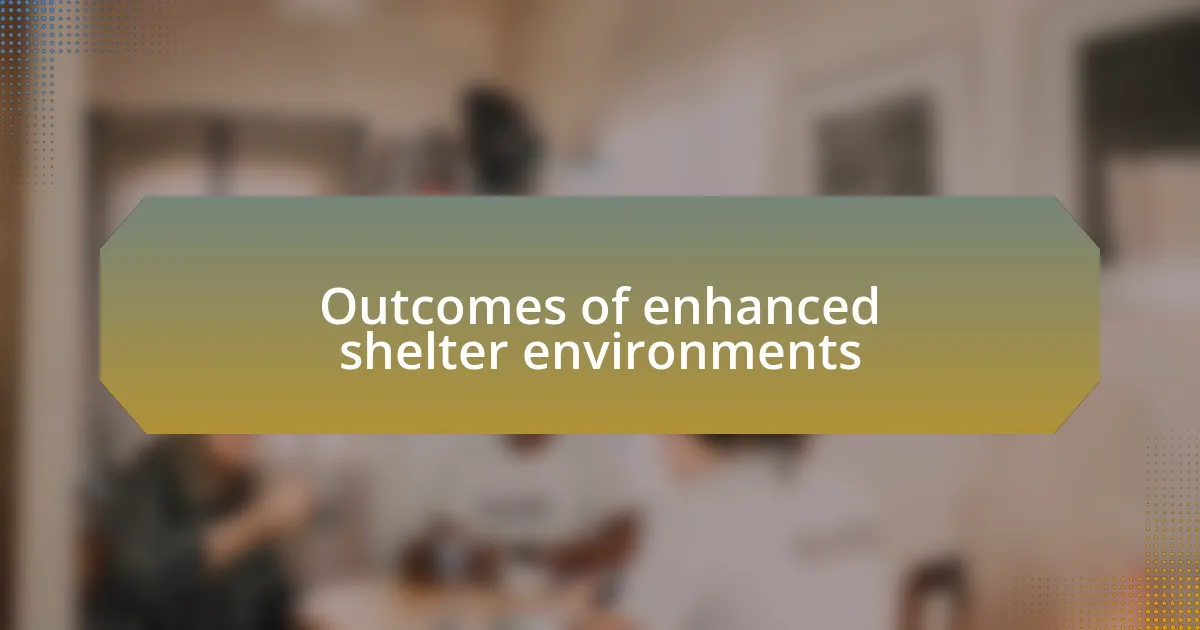Key takeaways:
- Homelessness charity provides essential support beyond shelter, offering hope and opportunities for reintegration into society.
- A nurturing shelter environment fosters healing, resilience, and community connections, significantly impacting residents’ well-being.
- Challenges in shelters, such as overcrowding and lack of privacy, hinder recovery and highlight the need for comprehensive support services.
- Engaging the community and volunteers through shared activities and storytelling enhances understanding and commitment to addressing homelessness.

Understanding homelessness charity
Homelessness charity plays a vital role in addressing the needs of those without stable housing. Reflecting on my experiences volunteering at a local shelter, I remember the heartfelt conversations I had with individuals who felt invisible to society. It made me wonder: how can we cultivate empathy in our communities to support those in need?
Understanding the essence of homelessness charity means recognizing that it often provides more than just shelter; it offers hope and opportunity. I recall one man sharing his story of how the assistance he received helped him secure a job and reintegrate into society. Moments like this remind me that charity has the power to transform lives, but what more can we do to empower these individuals?
Every act of kindness, no matter how small, contributes to a larger movement against homelessness. During my time volunteering, I often felt a profound connection with those I served, realizing that their struggles are not just theirs alone. It raises an important question: how can we, as a society, dismantle the stigma attached to homelessness and foster an environment of acceptance and support?

Importance of shelter environment
The shelter environment is a sanctuary where individuals can begin to heal. I still remember the first time I stepped into a shelter filled with warmth and kindness. It struck me that a safe, welcoming space can ignite a spark of hope in someone who has felt abandoned by the world. How powerful it is to think that the simple act of creating a comfortable environment can foster resilience!
I’ve observed firsthand how crucial the physical and emotional atmosphere is in shelters. The small touches—a clean bed, cheerful decor, and supportive staff—can significantly impact a person’s state of mind. I recall a guest who, after receiving positive affirmation and encouragement, slowly transformed from being withdrawn to engaging with others. Isn’t it amazing how a nurturing environment can lift someone’s spirit?
Moreover, the shelter environment sets a tone for community and belonging. When I helped organize group activities, I saw individuals form connections that transcended their hardships. This sense of camaraderie is essential, as it helps dismantle feelings of isolation. How can we further cultivate these connections to foster a more united front against homelessness?

Common issues in shelter settings
One of the most pressing issues I’ve seen in shelter settings is overcrowding. When the space is packed beyond its capacity, it becomes difficult to maintain a safe and comfortable atmosphere. I once witnessed how the stress of being crammed together made it hard for individuals to relax or feel secure. Have you ever tried to find peace in a place that felt chaotic? It’s nearly impossible.
Another challenge is the lack of privacy. Most shelters offer communal sleeping arrangements, which can be daunting for someone who has already endured significant trauma. I remember speaking with a woman who shared how the absence of personal space made her feel vulnerable. We often underestimate the importance of having a little corner that one can call their own. How can we expect someone to heal without moments of solitude?
Additionally, inadequate access to resources like mental health support and job training programs can deeply hinder the recovery process. I once met a veteran who struggled with PTSD, and the shelter’s lack of specialized services left him feeling lost and overwhelmed. It made me realize that beyond just providing a roof, shelters must also address the comprehensive needs of their guests. Isn’t it essential to equip those in shelters with tools that spark long-term change?

Strategies for improving shelter facilities
Enhancing shelter facilities begins with creating more private spaces for individuals. I remember visiting a shelter where staff had repurposed storage areas into small sleeping pods. This simple change provided guests with a sense of ownership and security. Isn’t it fascinating how something as straightforward as a designated nook can transform someone’s experience?
In addition to privacy, improving access to resources is vital. In one shelter I supported, they partnered with local organizations to offer onsite workshops that covered everything from resume building to mental health support. Witnessing guests engage in these programs truly highlighted how vital it is to provide opportunities that empower individuals. Don’t we all flourish when given the chance to learn and grow?
Finally, I’ve seen how uplifting the environment through simple aesthetics, like adding artwork and plants, can make a difference. During a community event, we painted murals together, which not only beautified the space but brought people closer. When a place feels welcoming, it can spark hope and remind individuals that they are not alone in their journey. What does it say about us when we prioritize creating a nurturing environment for those in need?

Engaging volunteers and community
Engaging volunteers and the community is essential for the success of any shelter initiative. I recall a heartwarming afternoon spent organizing a community potluck where volunteers, guests, and local residents came together to share food and stories. Conversations flowed easily, and the laughter that filled the air reminded me how connection can dispel stigma. Isn’t it amazing how a shared meal can break down barriers and foster understanding?
Another impactful experience was initiating a volunteer training program focused on empathy and active listening. I led a workshop where we not only discussed the challenges faced by our guests but also engaged in role-playing scenarios. Participants left with a deeper appreciation for the experiences of those they were serving, sparking a sense of commitment that can drive real change. Have you ever felt the warmth of connecting on a human level, knowing you’re making a difference?
Moreover, I believe that showcasing the stories of our volunteers and guests through community events can amplify our mission. I once helped create a gallery featuring portraits and testimonials from individuals who found hope through our shelter. The shared narratives resonated within the community, inspiring others to get involved. How powerful is it when people learn about the faces behind the cause, transforming mere support into a shared responsibility?

Personal experiences in shelter improvements
In my journey to improve the shelter environment, I decided to implement a feedback system where guests could voice their thoughts and suggestions. One evening, a guest shared his idea for a communal garden, and I could see the spark in his eyes as he described his vision. Watching that space transform from an empty lot into a vibrant garden, filled with laughter and cooperation, reminded me that we all have the capacity to contribute to our surroundings. Isn’t it incredible how a simple suggestion can bloom into something beautiful?
I also took a personal interest in decorating the common areas of the shelter. I remember visiting a local thrift store and finding colorful wall art, which I believed could uplift spirits. When volunteers and I put those pieces up, the change was palpable— the once stark walls now exuded warmth and personality. It made me reflect on how our environment significantly influences our mood. Have you ever noticed how a little color can brighten your day?
Another memorable experience was when we coordinated a monthly movie night with a cozy theme. I invited guests to suggest their favorite films, and we set up a projector in the main area. The excitement was tangible as we settled in with blankets and popcorn. Watching their faces light up with joy reminded me of the simple pleasures we sometimes take for granted. How often do we overlook the power of shared joy and laughter in creating a sense of belonging?

Outcomes of enhanced shelter environments
Transforming the shelter environment led to a remarkable sense of community among residents. I distinctly recall an evening when I overheard a few guests chatting about their day while preparing a communal meal together. Their laughter filled the room, and for a moment, it felt like family gathering around the dining table instead of individuals navigating hardships. Don’t you think that even small interactions can significantly uplift the spirit of a space?
We also noticed that providing a calmer atmosphere resulted in improved mental well-being for many residents. There was one particular instance where we created a quiet reading nook with cozy chairs and books. Several guests began to spend time there, and it was heartwarming to see them escape into different worlds through their reading. Isn’t it fascinating how offering a simple space for reflection can lead to such profound changes in mood and outlook?
Perhaps one of the most impactful outcomes was witnessing how a well-maintained environment fostered empowerment and responsibility. I vividly remember when a group of residents took the initiative to clean and personalize their shared living area. Their investment of time and effort transformed it into a welcoming haven. Isn’t it empowering to see how ownership over one’s environment can inspire pride and a sense of belonging?